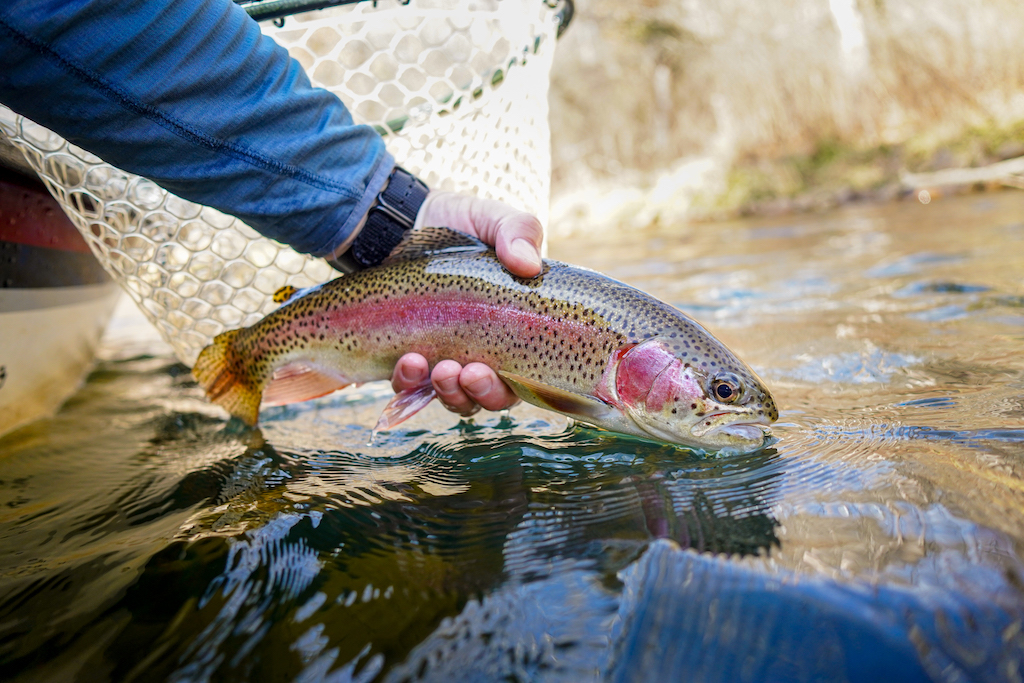
Best Fly Fishing in Tennessee: Top 12 Fisheries
Tennessee stands as a premier destination for fly fishing enthusiasts, thanks to its diverse and rich fisheries that carve through the state’s varied landscapes. From the misty mountains of the east to the rolling hills of the central regions, Tennessee’s waters are a haven for a wide array of fish species, with trout taking center stage. The state’s rivers, streams, and lakes are home to an impressive variety of trout, including the elusive wild brown, the vibrant rainbow, and the cherished native brook trout, offering anglers the chance to engage with these species in their natural habitats.
This article aims to be your ultimate guide to the best fly fishing in Tennessee, spotlighting the top 12 fisheries that make the Volunteer State a bucket-list destination for fly fishers worldwide. Each location is a unique gem, offering its own set of challenges and rewards, from the adrenaline-pumping pursuit of trophy trout to the serene enjoyment of unspoiled natural beauty. We’ll delve into the distinct offerings of each spot, including the types of trout you can expect to encounter, the most effective flies to use, and the optimal times to cast your line. Join us as we explore the rich tapestry of fly fishing experiences that Tennessee has to offer, ensuring you have all the information needed for a successful and memorable fishing adventure.
South Holston River
In Bristol, the South Holston River sets itself apart with a remarkable array of trout, most notably its wild brown trout and the generously stocked rainbow trout. This river serves as a testament to the rich aquatic life of Tennessee, offering both the challenge of catching the cunning wild browns and the joy of engaging with the plentiful rainbows.
SoHo Fly Selection
For those casting their lines into the South Holston, choosing the right fly is paramount. Sulphurs and Blue Winged Olives are crucial during their peak hatches, perfectly imitating the insects that trout cannot resist. For anglers aiming to hook the larger, more elusive brown trout, streamers are the key, mimicking the movement and size of the baitfish that these predators target.
Best Time to Fish the SoHo
The optimal fishing times on the South Holston River vary with the seasons. During the summer, the river comes alive in the early mornings and late evenings, when the water temperatures are cooler, and trout are most active. In contrast, the cooler months shift the ideal fishing window to midday, when the sun warms the water slightly, encouraging trout to feed more aggressively. This seasonal rhythm ensures that the South Holston offers a year-round retreat for anglers seeking both tranquility and the thrill of the catch.
Clinch River
The Clinch River is distinguished by its high-quality wild brown trout and abundant stocked rainbow trout, creating a dynamic fly fishing environment. This river provides a blend of challenge and opportunity, with the elusive wild browns appealing to experienced anglers and the stocked rainbows offering plentiful catches for all levels of fishing expertise.
Clinch River Fly Selection
Effective fly selection on the Clinch River is crucial for a fruitful day of fishing. Zebra Midges and Scuds are year-round staples, perfectly imitating the small aquatic invertebrates that form a significant part of the trout’s diet. During hatch seasons, Sulphurs become particularly effective, matching the natural insects that emerge and attracting trout to the surface for a feast.
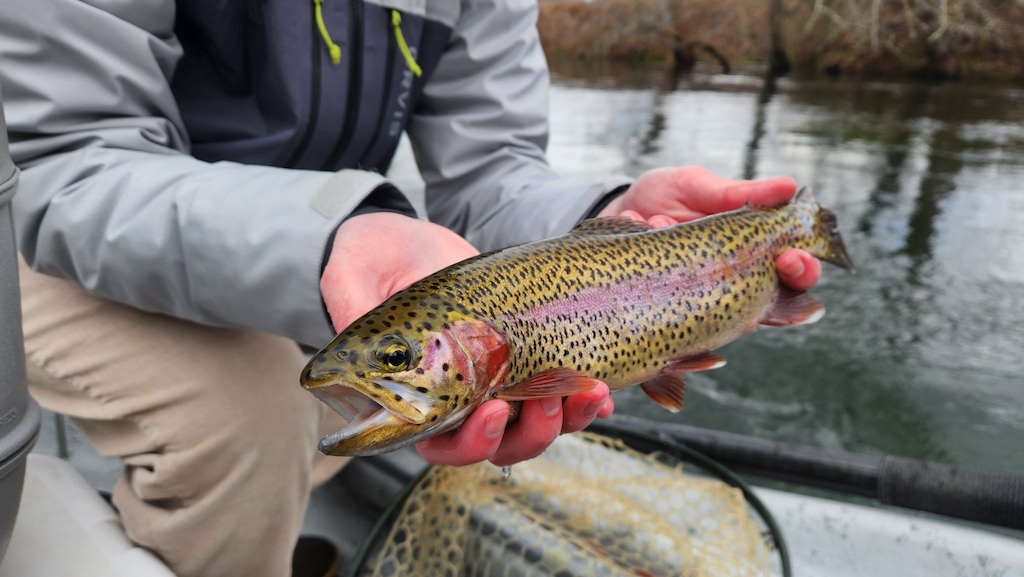
Best Time to Fish the Clinch
Timing on the Clinch River is heavily influenced by the water flow rates, which are dictated by the dam’s release schedule. Anglers find the most success fishing after scheduled water releases, as the increased flows stir up the riverbed, bringing food into the current and activating the trout’s feeding instincts. Understanding and planning around these releases are essential for capitalizing on the prime fishing conditions the Clinch River offers, ensuring both a productive and exhilarating fishing experience.
Caney Fork River
The Caney Fork River is a treasure trove for anglers, boasting a generous stocking program that ensures a steady population of rainbow, brown, and brook trout. This diversity allows for a vibrant fishing experience, catering to a wide range of preferences and techniques. The stocked trout ensure that every visit has the potential for success, making the Caney Fork a favored destination among Tennessee’s fly fishing spots.
Caney Fork Fly Selection
On the Caney Fork, the key to a successful catch lies in the versatility of your fly box. Midges are essential, especially in smaller sizes, to match the prevalent aquatic invertebrates. Wooly Buggers offer a more aggressive option, ideal for enticing larger trout looking for a substantial meal. San Juan Worms replicate the worms and larvae dislodged by water currents, a tempting snack for trout in various conditions.
Best Times to Fish the Caney Fork
The Caney Fork River offers excellent year-round fishing opportunities, but the best times to cast your line are during the early morning and late evening in the warmer months. These periods see lower light conditions, which encourage trout to feed more actively at the surface. The reduced human activity during these times also contributes to a more serene and productive fishing environment, enhancing the overall experience on the Caney Fork.
Hiwassee River
Just outside of Chattanooga, the Hiwassee River, with its scenic beauty and abundant waters, is home to a healthy population of both wild and stocked rainbow and brown trout. This unique blend offers anglers the thrill of engaging with trout that have grown up in the wild, alongside the reliability of stocked fish. The diversity in trout population makes the Hiwassee a versatile fishing destination, catering to a wide spectrum of fly fishing enthusiasts seeking different types of challenges and experiences.
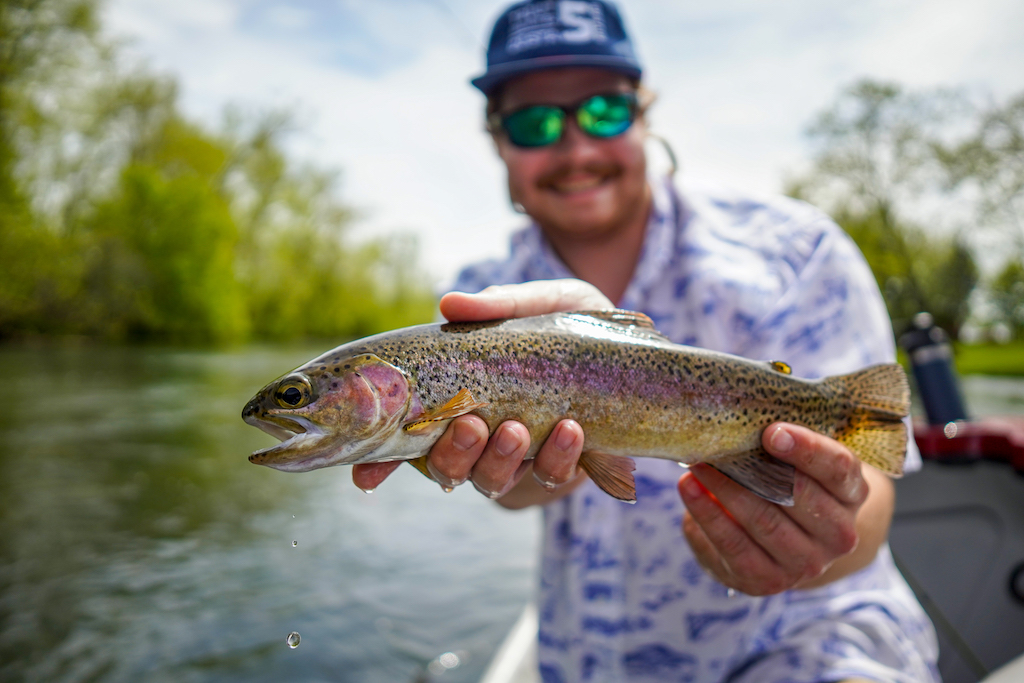
Hiwassee River Fly Selection
The Hiwassee River’s ecosystem supports a rich aquatic life, including a variety of insect hatches that trout feed on. Caddis, Mayflies, and Stoneflies are essential inclusions in any angler’s fly box when heading to the Hiwassee. These flies mimic the natural diet of the trout throughout the year, with specific patterns and sizes becoming more effective as the seasons change and different hatches occur.
Best Times to Fish the Hiwassee
The optimal fishing season on the Hiwassee River spans from late spring through fall, a period characterized by significant insect activity and favorable water temperatures. However, the river’s fishing conditions are also heavily influenced by water releases from the dam. Anglers should pay close attention to the release schedules, as these events can dramatically improve the fishing conditions, stimulating trout activity and feeding behaviors, thus providing windows of opportunity for productive fishing.
Tellico River
The Tellico River is celebrated for its large stocked rainbow trout and elusive native brook trout, making it a standout destination for anglers in Tennessee. The river’s stocking program ensures a robust population of rainbow trout, offering ample opportunities for successful catches. Meanwhile, the native brook trout, thriving in the river’s pristine waters, provide a unique challenge for those seeking to connect with the indigenous species of the region.
Tellico Fly Selection
To maximize success on the Tellico River, anglers should equip themselves with a variety of flies. Stoneflies and March Browns are particularly effective during their respective hatches in the spring, closely imitating the natural prey of trout in the river. Wooly Buggers serve as a versatile option, appealing to the predatory instincts of both rainbow and brook trout with their lifelike swimming action, making them a must-have in any fly fisherman’s arsenal.
Best Times to Fish the Tellico
The prime fishing season on the Tellico River spans from spring to early summer, a period when the river’s ecosystem is most vibrant, and trout are actively feeding. Anglers should be mindful of the delayed harvest regulations that are in place, designed to protect the fish populations and enhance the fishing experience. These regulations often dictate catch-and-release practices and the use of artificial flies only, ensuring the sustainability of the river’s trout fisheries for future generations.
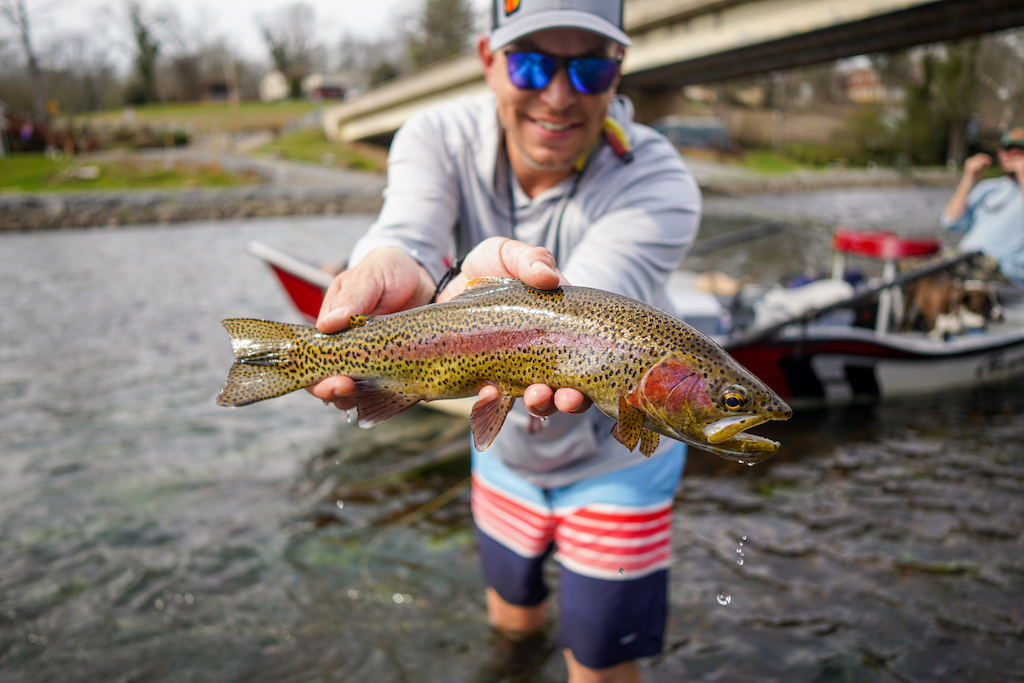
Watauga River (Tailwater)
The Watauga River, particularly the tailwaters flowing through Elizabethton, boast a remarkable diversity of trout, offering anglers the chance to catch wild and stocked browns, rainbows, and brook trout. This mix ensures a dynamic fishing experience, where the challenge of catching wild trout blends with the excitement of abundant stocked populations. The presence of brook trout adds a special allure, making the Watauga an essential destination for Tennessee fly fishers seeking variety and quality.
Watauga River Fly Selection
Effective fly fishing on the Watauga River requires a well-curated selection of flies. Midges are indispensable year-round, particularly in smaller sizes to match the prevalent hatch and satisfy the selective appetites of trout. Caddis patterns are highly effective during their hatch periods, mimicking one of the primary food sources for trout in this river. Additionally, a variety of nymphs should not be overlooked, as they can entice trout feeding below the surface, especially in between hatches.
Best Times to Fish the Watauga
The optimal fishing seasons on the Watauga River are spring and fall, periods marked by significant insect activity and ideal water temperatures. These seasons witness the most prolific hatches, providing anglers with the best opportunities to engage in dry fly fishing and witness trout actively feeding on the surface. Attention to hatch schedules and water conditions during these times can significantly enhance the fishing experience, making each visit to the Watauga River both productive and memorable.
Abrams Creek
Abrams Creek stands out in the Tennessee fly fishing landscape for its population of large wild brown trout. This stream, nestled within the Great Smoky Mountains National Park near Gatlinburg, offers a pristine environment where these majestic fish thrive, providing anglers with the chance to pursue some of the most challenging and rewarding trout fishing in the region. The presence of large wild browns in Abrams Creek is a testament to the health and vitality of its waters, making it a coveted destination for serious trout angler looking for trout streams less traveled.
Abrams Creek Fly Selection
To successfully engage the discerning trout of Abrams Creek, anglers should focus on Terrestrials during the summer months, as these patterns effectively imitate the insects that frequently fall into the water, such as ants, beetles, and grasshoppers. In the fall, Blue Winged Olives become particularly effective, matching the natural hatch that occurs during this season and enticing trout to the surface for a feast.
Best Times to Fish Abrams
The ideal fishing season in Abrams Creek extends from late spring through fall, a period characterized by dynamic insect activity and optimal water conditions for trout. However, anglers should pay special attention to park access times, as regulations within the Great Smoky Mountains National Park can influence when and where fishing is permitted. Planning visits around these access times is crucial for maximizing time on the water and ensuring a successful fishing experience in this unique and beautiful trout fishery.
Citico Creek
Citico Creek, nestled in the lush landscapes of the Cherokee National Forest, is a haven for anglers seeking the thrill of catching wild trout in their natural habitat. This creek is home to a healthy population of wild rainbow and brown trout, with the occasional brook trout adding to the creek’s fishing allure. The diversity of trout species makes Citico Creek a rewarding destination for fly fishers who appreciate the beauty and challenge of pursuing wild fish in serene, untouched settings away from the crowds.
Citico Creek Fly Selection
Successful fishing in Citico Creek relies on a versatile fly selection that can adapt to the varied conditions and feeding patterns of its trout. Nymphs are a staple, effective in reaching the deeper pockets where trout often feed, while dry flies excel during hatch periods, enticing trout to the surface. Streamers offer an aggressive option for targeting larger trout, mimicking the small fish and other prey these predatory fish hunt.

Best Times to Fish Citico
The best times to fish Citico Creek are during the spring and fall, when water temperatures are ideal for trout activity, and the creek is alive with insect hatches. These seasons offer the optimal balance of weather, water conditions, and trout behavior, making them prime times for fly fishing. However, anglers should be cautious of high water levels during the rainy seasons, as these can make fishing difficult and potentially hazardous. Planning trips outside of these high-water periods ensures not only a safer fishing experience but also a more productive one, as lower water levels provide better access to trout habitats and feeding lanes.
Doe River
The Doe River, particularly renowned for its breathtaking gorge area, is a sanctuary for anglers pursuing wild brown and rainbow trout. The rugged beauty of the gorge not only provides a stunning backdrop for fly fishing adventures but also shelters a vibrant population of trout. These wild fish offer a level of challenge and satisfaction that appeals to the purist angler, making the Doe River a must-visit for those seeking the authentic thrill of fly fishing in natural, unspoiled settings. The local Overmountain TU chapter has also put together the DRiFT trail right outside of Roan Mountain State Park that is a must visit for anglers!
Doe River Fly Selection
Effective fishing in the Doe River calls for a focused approach to fly selection. Small Nymphs are crucial, as they can navigate the varied underwater terrains of the river, reaching the spots where trout like to feed. Dry Flies become particularly effective during hatch periods, when trout are more likely to rise to the surface for their meals. These flies should be chosen with the river’s specific conditions in mind, matching the size and pattern of the natural insects present.
Best Times to Fish the Doe
The Doe River shines as a fly fishing destination during spring and fall. Spring brings higher water levels, courtesy of the melting snow and seasonal rains, providing ideal conditions for nymph fishing as trout become more active in search of food. Fall, on the other hand, offers not only the visual spectacle of changing foliage but also an increase in trout activity, making it a perfect time for both nymph and dry fly fishing. These seasons offer distinct experiences on the Doe River, with spring focusing on the challenge of navigating higher waters and fall offering a harmonious blend of beauty and bountiful fishing opportunities.
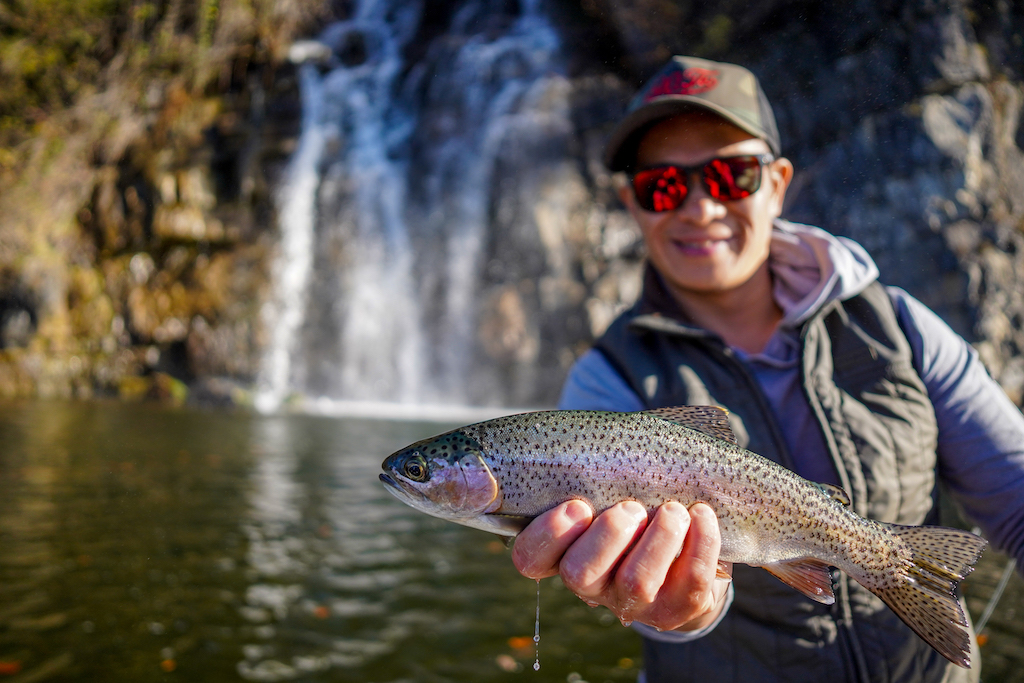
Elk River
The Elk River is a prime destination for anglers looking to land stocked rainbows and browns, with the added allure of potentially hooking into trophy-sized fish. This river’s stocking program ensures a consistent population of trout, making it a reliable spot for those seeking the excitement of catching large, robust fish. The potential for trophy catches adds a thrilling dimension to fly fishing on the Elk, drawing both novice and experienced anglers eager to test their skills against some of the most impressive trout in Tennessee.
Elk River Fly Selection
To maximize success on the Elk River, anglers should focus on a trio of effective fly types. Streamers are key for enticing the river’s larger trout, imitating the baitfish these predatory fish feed on. Nymphs offer a more subtle approach, ideal for targeting trout feeding below the surface on aquatic invertebrates. Egg Patterns mimic the spawn of other fish, a high-calorie meal that trout find irresistible, especially after the stocking events when the fish are adjusting to their new environment.
Best Times to Fish the Elk
The Elk River is most productive after stocking events in the spring and fall, when the fresh influx of trout are acclimating and more aggressively feeding, increasing the chances of a successful catch. Additionally, the morning and evening hours during the summer present optimal fishing conditions, as the cooler temperatures of these times encourage trout to be more active. These periods avoid the midday heat, which can often make trout lethargic and less likely to feed, thus providing anglers with the best opportunity to experience the Elk River’s full potential.
Laurel Fork
Laurel Fork stands as a serene retreat for those seeking the subtle thrill of fly fishing for wild trout in Tennessee. This stream is predominantly inhabited by wild rainbow trout, offering a pure and challenging fishing experience. The presence of some brook trout adds to the allure, providing anglers with variety and the chance to target two of the most sought-after species in the fly fishing world. The wild nature of these trout makes each catch a rewarding achievement, reflecting the angler’s skill and the vibrant ecosystem of Laurel Fork.
Laurel Fork Fly Selection
Success in the clear, fast-flowing waters of Laurel Fork often comes down to the choice of flies. Dry Flies are essential for tempting surface-feeding trout, especially during hatch periods when insects are abundant. Small Nymphs play a critical role in probing the deeper waters where trout often lurk, waiting for prey. The key is subtlety and precision, with patterns and sizes that closely mimic the natural diet of the trout in this pristine stream.
Best Times to Fish Laurel Fork
The optimal fishing season on Laurel Fork spans from late spring to early fall, a timeframe when water levels are most conducive to fly fishing. During these months, the stream’s flow is ideal, neither too high to make wading dangerous nor too low to concentrate trout and make them overly wary. This period also coincides with the most active feeding times for trout, as warmer temperatures increase their metabolism and, consequently, their need to feed. Anglers visiting Laurel Fork during these times can enjoy not only the beauty of the changing seasons but also the heightened opportunity for a successful day on the water, surrounded by the unmatched tranquility of Tennessee’s wilderness.
Stoney Creek
Stoney Creek offers a unique fly fishing experience with its populations of small wild trout, including both rainbow and brook varieties. This creek is a testament to the resilience and diversity of Tennessee’s trout ecosystems, providing anglers with the joy of connecting with fish in their most natural state. The smaller size of Stoney Creek’s trout challenges anglers to refine their techniques and approach, making every catch a rewarding testament to skill and patience.
Stoney Creek Fly Selection
To succeed in the clear, swift waters of Stoney Creek, anglers should rely on Light Nymphs and Dry Flies. These selections are crucial for mimicking the small insects that constitute the primary diet of the creek’s trout. Light nymphs are perfect for exploring the deeper pools and runs where trout often hide, while dry flies offer the excitement of surface strikes during hatch periods. The subtlety and precision of these flies are key to enticing the wary, wild trout of Stoney Creek.
Best Times to Fish Stoney Creek
The best fishing experiences on Stoney Creek come during the summer months for dry fly fishing, when insect activity is at its peak and trout are more likely to feed on the surface. Spring and fall present the optimal conditions for nymphing, as fluctuating water levels and temperatures encourage trout to feed more aggressively, making them more receptive to subsurface presentations. These seasons offer anglers the chance to engage with the creek’s dynamic trout populations, enjoying the serene beauty of the surrounding landscape while pursuing the art of fly fishing.
Gear and Preparation for Tennessee Fly Fishing
Embarking on a fly fishing adventure in Tennessee’s diverse waters requires not only skill and knowledge but also the right gear. Essential equipment includes a versatile fly rod—often a 5-weight for its all-around utility in various fishing conditions—a reliable reel, and a selection of flies that match the local hatches. A good waterproof wader and comfortable, sturdy wading boots are also crucial for navigating the streams and rivers of Tennessee.
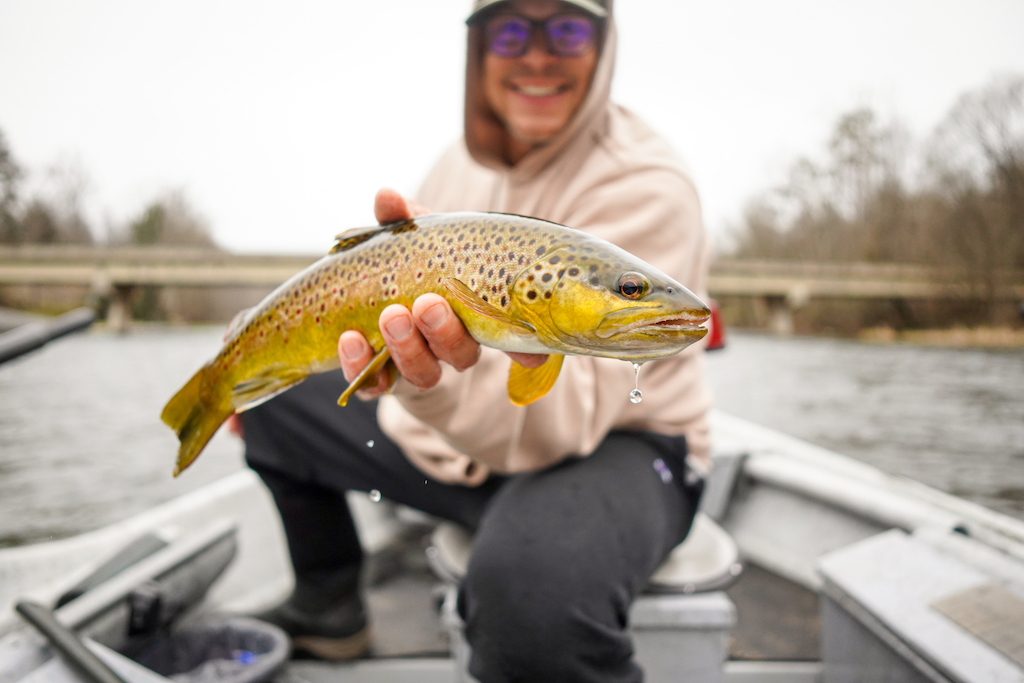
When it comes to rigging, selecting the right tippet and leader size is vital for fooling Tennessee’s wary trout. For smaller trout and clear water conditions, a lighter tippet (5X to 7X) is advisable to ensure stealth. For targeting larger species or fishing in murkier waters, a heavier tippet (3X to 4X) might be more appropriate to withstand the fight without sacrificing subtlety.
Before heading out, obtaining a Tennessee fishing license is mandatory for anglers of nearly all ages. This not only complies with state law but also contributes to conservation efforts, ensuring the health and sustainability of Tennessee’s fish populations. Familiarizing yourself with local regulations—such as catch limits, size restrictions, and specific area rules—is equally important to ensure a responsible and enjoyable fishing experience. Proper preparation, respect for the environment, and adherence to regulations are key to a successful and fulfilling fly fishing adventure in Tennessee.
Celebrating Tennessee’s Fly Fishing Riches
Our journey through the top 12 fly fishing spots in Tennessee reveals a state abundant in both variety and quality of angling experiences. From the trophy waters of the South Holston River to the wild streams of Stoney Creek, each location offers something unique for every angler. Whether you’re drawn to the challenge of landing a large wild brown trout, the thrill of catching stocked rainbows, or the serenity of pursuing native brook trout in pristine waters, Tennessee’s rivers and streams provide a backdrop for unforgettable fishing adventures.
As we cherish these fly fishing treasures, let’s also remember the importance of respecting the natural beauty and supporting conservation efforts in these areas. Our commitment to preserving these habitats ensures that future generations can enjoy the same thrilling experiences we have today.
We invite you, our fellow anglers, to share your own stories, tips, and favorite spots for fly fishing in Tennessee. By fostering a community of passionate and responsible anglers, we not only enrich our own fishing experiences but also contribute to the stewardship of Tennessee’s extraordinary aquatic ecosystems. Let’s continue to celebrate the art of fly fishing and the natural wonders that make Tennessee a premier destination for anglers worldwide.
